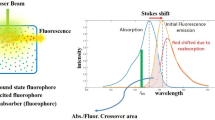Abstract
The incorporation of spectroscopic techniques into diagnostic procedures may greatly improve the chances for precise diagnostics. One promising technique is fluorescence spectroscopy, which has recently been used to detect many different types of diseases. In this work, we use laser-induced tissue fluorescence to detect hepatocarcinoma in rats using excitation light at wavelengths of 443 and 532 nm. Hepatocarcinoma was induced chemically in Wistar rats. The collected fluorescence spectrum ranges from the excitation wavelength up to 850 nm. A mathematical procedure carried out on the spectrum determines a figure of merit value, which allows the detection of hepatocarcinoma. The figure of merit involves a procedure which evaluates the ratio between the backscattered excitation wavelength and the broad emission fluorescence band. We demonstrate that a normalization allowed by integration of the fluorescence spectra is a simple operation that may allow the detection of hepatocarcinoma.
Similar content being viewed by others
References
F. X. Bosch, J. Ribes, and J. Barros, “Epidemiology of Primary Liver Cancer,” Semin Liver Dis. 19, 271 (1999).
V. C. Nzeaks, Z. D. Goodman, K. G. Ishok, “Hepatocellulas Carcinoma in Cirrhotic and Noncirrhotic Livers: A Clinic-Histopathologic Study of 804 North American Patients,” Am. J. Clin. Pathol. 105, 65 (1996).
F. V. Cookley and L. H. Schwortz, “Imaging of Hepatocellular Carcinoma: A Practical Approach,” Semin. Oncol. 28(5), 460 (2001).
A. Policard, “Etude sur les aspects offerts par des tumeur experimentales examinees a la lumiere de Wood,” Compendeus Soc. Biol. 91, 1423 (1924).
F. Ronchese, B. S. Walker, and R. M. Young, “The Reddish-Orange Fluorescence of Necrotic Cancerous Surfaces under the Wood Light,” Arch. Dermatol. Syphilis 69, 31 (1954).
R. R. Alfano, D. B. Tata, J. Cordero, et al., “Laser Induced Fluorescence Spectroscopy from Native Cancerous and Normal Tissue,” IEEE J. Quantum Electron. 20, 1507 (1984).
A. Gillenwater, R. Jacob, R. R. Kortum, “Fluorescence Spectroscopy: A Technique with Potential to Improve the Early Detection of Aerodigestive Tract Neoplasia,” Head Neck 20, 556 (1998).
M. Broglia., “Blue-Green Laser Induced Fluorescence from Intact Leaves,” Appl. Opt. 32, 334 (1993).
J. K. Dhingra et al., “Early Diagnosis of Upper Aerodigestive Tract Cancer by Autofluorescence,” Arch. Otolaryngol. Head Neck Surg. 122, 1182 (1996).
G. A. Wagniéres, W. M. Star, and B. C. Wilson, “In vivo Fluorescence Spectroscopy and Imaging for Oncological Applications,” Photochem. Photobiology 68, 603 (1998).
S. C. Vari, T. G. Papazolou, et al., “Intraoperative Metastase Detection by Laser Induced Fluorescence Spectroscopy,” Proc. SPIE 1426, 111 (1991).
D. B. Solt and F. F. Farber, “New Principle for the Analysis of Chemical Carcinogenesis,” Nature 263, 701 (1976).
F. S. Moreno, M. B. S. L. Rizzi, M. L. Z. Dagli, and M. V. C. Penteado, “Inhibitory Effects of β-Carotene on Preneoplasic Lesions Induced in Wistar Rats by the Resistant Hepatocyte Model,” Carcinogenesis 12, 1817 (1991).
F. N. Ghadially and W. J. P. Neish, “Porphyrin Fluorescence of Experimentally Induced Cell Carcinoma,” Nature 188, 1124 (1960).
D. M. Harris and J. Werkhaven, “Endogenous Porphyrin Fluorescence in Tumors,” Lasers Surg. Med. 7, 467 (1987).
J. Bloomer, “The Porphyries,” in Diseases of the Liver, Ed. by E. R. Schiff, M. F. Sorrel, and W. C. Maddrey (Lippincott-Raven, Philadelphia, 1999), Vol. 1, pp. 1151.
Author information
Authors and Affiliations
Additional information
Original Text © Astro, Ltd., 2006.
Rights and permissions
About this article
Cite this article
Marcassa, J.C., Ferreira, J., Zucoloto, S. et al. Detection of hepatocarcinoma in rats by integration of the fluorescence spectrum: Experimental model. Laser Phys. 16, 827–832 (2006). https://doi.org/10.1134/S1054660X06050136
Received:
Issue Date:
DOI: https://doi.org/10.1134/S1054660X06050136




